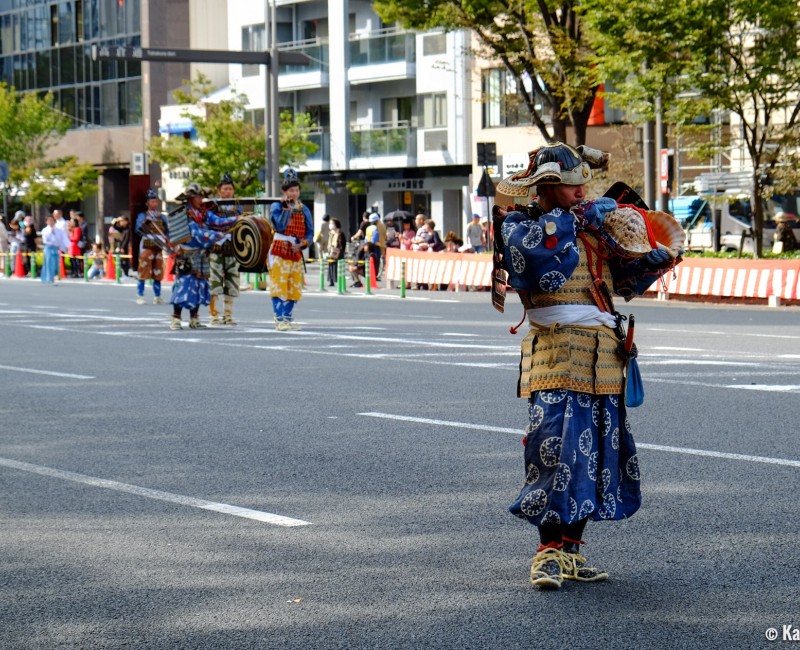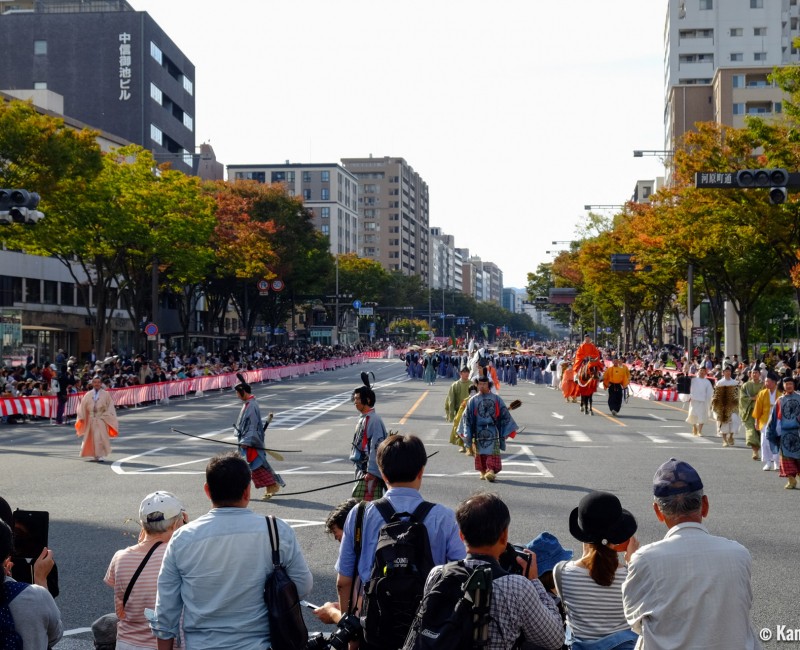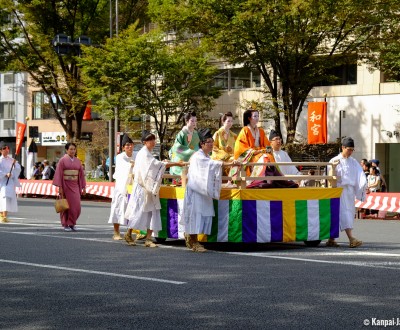Jidai Matsuri
Historical Procession in Kyoto
Jidai Matsuri is one of the three most important annual festivals in Kyoto and is held on October 22 each year. About two thousand participants, donned in Japanese traditional costumes, reenact the city’s history through Japan’s historical landmarks. This procession was established in 1895 and tours downtown Kyoto, between the Imperial Palace and Heian shrine.
Jidai Matsuri is the last great festival of the year in Kyoto, as well as the autumnal counterpart of spring’s Aoi Matsuri. The two events share many characteristic features:
- The reenacting of more than 1,000 years of Japanese history;
- A large array of traditional costumes;
- A very solemn aspect of the parade: very few animations and a slow walking procession;
- A high number of participants: about a couple of thousand men, women and children;
- The participation of animals: mainly horses for yabusame (Japanese horseback archery) and oxes to draw carriages.
The essential difference between the two festivals is on the spiritual aspect. Aoi Matsuri is strongly linked to Shinto religion and to Kyoto’s Kamo and Shimogamo shrines’ deities. On the other hand, Jidai Matsuri’s procession is dedicated to the main powerful personalities in Japan, such as daimyo lords and shoguns. Only two mikoshi portable shrines are exhibited at the end of the parade and dedicated to emperors Kanmu and Komei, enshrined in Heian-jingu. The two emperors were respectively the first and the last to have their residence in Kyoto when it was the country’s capital.

For history of Japan’s connoisseurs
Kyoto’s current official representatives, especially the mayor and the prefecture’s governor, lead Jidai Matsuri’s procession. Then in a reverse chronological order come the Modern Times, from Meiji Era and the end of Edo Period (1603-1868), up to Heian Period (794-1185) at the end of the cortege.
Each age is represented by several famous characters: for example, the crucial Azuchi-Momoyama Period (1573-1603) group features Japan’s three unifiers: Oda Nobunaga, Toyotomi Hideyoshi and Tokugawa Ieyasu; another represents Heian-kyo’s former imperial court’s intellectuals and thinkers.
The procession, that can be quite monotonous, lasts more than two hours, and is occasionally animated by musicians and dancers, so Jidai Matsuri is particularly recommended to those who have a special appetency for Japanese history or period costumes. As a matter of fact, a few explanations are given in Japanese and in English through microphones near the largest avenues, but they are brief and are not enough to understand what’s happening without a sound knowledge of the subject.

The course of the costumed parade
The procession starts on October 22, at noon, from the vast plaza of Kyoto Imperial Palace.
Then, it walks by several large avenues and streets in the center of the city to reach Heian-jingu shrine, located on the north-east of Kyoto. At the intersection of Kurasuma-dori and Oike-dori, the sides of the road have been arranged for paid seats that must be booked in advance. As Jidai Matsuri is not as crowded as the spring and summer festivals, booking a seat is not necessary.
Moreover, it can be more interesting to move along the procession for the view: the smallest streets allow to better see the details of the costumes, but there is no explanation. It is quite easy to walk backwards the procession on the sidewalk (crossing the road is not possible though).
Heian-jingu is another good viewing spot. Being the end of the procession, it is easier there to get close to the participants, and even ask them to pose for a picture. Moreover, spectators tend to quickly leave as many of them usually go to Kurama, at the north of the city, to attend the fire festival also held on October 22 in the evening.
The procession’s path can be summarized as follows:
- 12 p. m.: Departure from Kyoto Gosho, the Imperial Palace, south gate;
- 12:30 p. m.: Procession in Karasuma, Oike, Karawaramachi and Sanjo streets (crossing of Kamo river)
- 2 p.m.: The parade continues on Jingu-michi street, along Okazaki Park
- 14:30 p.m.: Arrival at Heian-jingu shrine.
There are no yatai food stalls on the course, so it is recommended to bring a snack or to have an early lunch. In the same vein, it is better to arrive on the spot about one hour to thirty minutes before the scheduled passage of the cortege. The weather in autumn is usually fair and allows to observe the first color changing of the leaves while waiting.


